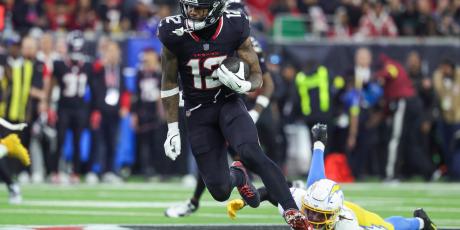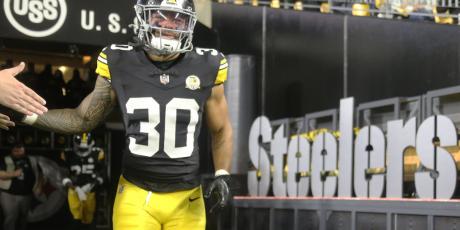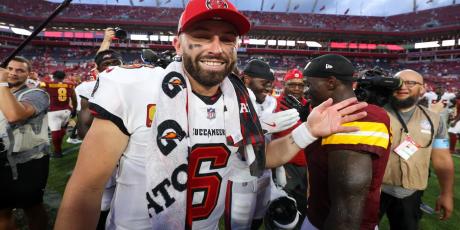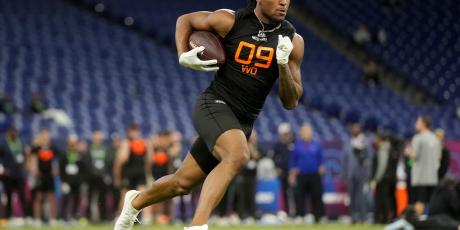Fanball Best-Ball Strategy: Player Win Rates and ADP

Rolling into March, we can begin to see through the smoke-and-confetti-filled haze that blanketed the end of the 2019 season and start to catch a glimpse of the shiny behemoth that is the 2020 fantasy football season. If you've been bitten by the best-ball bug, the answer to the question, "wait, isn't it a bit too soon to even think about a fantasy football team, not to mention draft one?" is always, "NO." Drafting in best-ball leagues at different points in the offseason offers different benefits along with unique obstacles, and it's never too early to look at the landscape of player valuation and value.
Before we look forward, though, we should first look back, and what better way than to take a look at last season's top player win rates? A player's win rate is the percentage of winning best-ball teams that rostered that player. Last week, Chris Allen took a look at win rates as they applied to best-ball roster construction. Here, I'll focus on some notable players using 2019 player ADP alongside their respective win rates, and also take a look at some late-round values at each flex-eligible position. Last year's success stories should lend some insight into how we should be approaching best-ball drafts in 2020. Tuck a napkin in your shirt and grab your silverware, because apparently in this metaphor you will be consuming some delicious best-ball content.
Quarterbacks
| Rank | Win% | ADP | Player |
|---|---|---|---|
| 1 | 20.70% | 11.13 | Lamar Jackson |
| 2 | 14.30% | 11.03 | Jameis Winston |
| 3 | 12.10% | 12.09 | Dak Prescott |
| 4 | 12.00% | 10.05 | Russell Wilson |
| 5 | 10.50% | 7.07 | Deshaun Watson |
| 7 | 10.10% | 11.09 | Kyler Murray |
| 8 | 9.20% | 10.07 | Carson Wentz |
| 9 | 8.60% | 10.05 | Drew Brees |
| 10 | 8.50% | 9.04 | Matt Ryan |
| 11 | 8.00% | 12.08 | Kirk Cousins |
| 12 | 8.00% | 13.09 | Jimmy Garoppolo |
Patrick Mahomes was the fantasy QB1 in 2018—Mahomes was not the fantasy QB1 in 2019. Mahomes joined a sizeable crew of quarterbacks who've failed to finish as the QB1 overall in fantasy for two consecutive seasons, and in fact, it's now been 16 years since a quarterback has managed the feat.
The chart above shows the 12 quarterbacks with the highest Fanball win percentages, and you'll notice that it's entirely populated by quarterbacks with ADPs in the sixth round or later. In fact, players who drafted their QB1 in the 11th round ended up with winning teams in the 75th-percentile. Speaking of the 11th round, there was a series of face-melting performances put on by a quarterback with an ADP in the late 11th to early 12th round.
Lamar Jackson, Ravens - 20.7% Win Rate, 12.01 ADP
Going into the 2019 season, Lamar Jackson was not generally valued as a fantasy QB1, as indicated by his ADP in the early 12th round of Fanball drafts. Jackson was the QB8 over the final seven games of the 2018 season after taking over for an injured Joe Flacco, and his ability to put up points as both a rusher and a passer should have piqued the interest of fantasy drafters more sharply in retrospect.
Jackson didn't just have the highest best-ball win percentage of any quarterback, his was a full 6.4 percentage points higher than the second-ranked quarterback (Jameis Winston). Christian McCaffrey and Austin Ekeler were the only players at any position to create higher win rates for best-ball owners than Jackson, making Jackson the 2019 standard-bearer for the late-round quarterback drafting strategy. Unfortunately, in early 2020 drafts, Jackson's ADP sits at 3.06 as the first quarterback off the board.
Dak Prescott, Cowboys - 12.1%, 12.09
Dak Prescott offered proof that while it's nice for a quarterback to provide eye-popping rushing totals, it's not entirely necessary for the success of your best-ball team. Prescott provided a third-best 12.1% win rate at the quarterback position while being most often drafted toward the end of the 12th round.
That's not to say that Prescott's efficiency when running with the ball isn't useful. His 32 rushing attempts were sixth-most at the position and his 5.3 yards per attempt were the fourth-best mark, but it was his improvement as a passer that was most notable. Prescott had a career-best 4,902 yards passing, and he was one of the most efficient quarterbacks on throws of 20 yards or more. Gone are the days of getting Prescott in the 12th round, but his 2020 ADP is 7.09 at the time of this writing, so he remains enticing as a QB1 option.
Running Backs and Wide Receivers
| Rank | Win% | ADP | Player |
|---|---|---|---|
| 1 | 36.70% | 1.02 | Christian McCaffrey |
| 2 | 22.90% | 8.04 | Austin Ekeler |
| 3 | 16.10% | 3.06 | Aaron Jones |
| 4 | 13.90% | 7.13 | Miles Sanders |
| 5 | 12.50% | 2.07 | Dalvin Cook |
| 6 | 11.90% | 3.03 | Leonard Fournette |
| 7 | 11.20% | 3.13 | Derrick Henry |
| 8 | 10.90% | 4.10 | Mark Ingram |
| 9 | 10.80% | 2.08 | Nick Chubb |
| 10 | 10.60% | 4.12 | Chris Carson |
| 11 | 10.50% | 7.09 | Latavius Murray |
| 12 | 10.30% | 16.02 | Jamaal Williams |
| Rank | Win% | ADP | Player |
|---|---|---|---|
| 1 | 16.30% | 4.12 | Chris Godwin |
| 2 | 15.80% | 1.10 | Michael Thomas |
| 3 | 14.10% | 3.01 | Keenan Allen |
| 4 | 14.10% | 16.09 | DeVante Parker |
| 5 | 13.80% | 12.09 | John Brown |
| 6 | 13.80% | 5.02 | Tyler Lockett |
| 7 | 13.50% | 14.02 | Jamison Crowder |
| 8 | 12.70% | 5.03 | Cooper Kupp |
| 9 | 12.00% | 5.09 | Allen Robinson |
| 10 | 12.00% | 5.02 | D.J. Moore |
| 11 | 11.90% | 2.09 | Mike Evans |
| 12 | 11.80% | 16.03 | Deebo Samuel |
Christian McCaffrey, Panthers - 36.7%, 1.02
If you had a top-three pick in a best-ball league in 2019, things probably worked out well for your team. Provided you drafted Christian McCaffrey, that is. McCaffrey rushed for over 1,300 yards, caught 116 of his 142 targets for over 1,000 yards, and threw in 19 combined touchdowns for some seasoning. His 36.7% win rate was nearly 14% higher than any other player.
Even with a high cost at his ADP of 1.02, he returned value, which is more than can be said of any of the remaining running backs with first-round ADPs, none of whom returned win rates that ranked in the top 12 at the position. What's more, McCaffrey put up back-to-back overall fantasy RB1 seasons with multiple quarterbacks in front of him, which helps to alleviate any concern about his value being tied to Carolina's starting quarterback. Despite his 1.01 ADP in 2020, it's easy to make an argument that he's properly valued.
Miles Sanders, Eagles - 13.9%, 7.13
For best-ball drafters who employed a "Zero RB" draft strategy, frequently from the later draft slots, Miles Sanders turned out to be a perfect target. Sanders was effective as a rusher, as his 811 rushing yards were the third-most among rookie running backs, but it was his usage in the passing game that really made him shine. Sanders's 62 targets were nearly double that of any other rookie running back, and his 418 receiving yards more than doubled his next-best rookie peer at the position.
Outside of the highest-profile rookie backs with the most NFL draft capital, the uncertainty surrounding rookie running backs generally results in ADPs that make them prime targets for hyper-fragile roster constructions. Sanders is now a fantasy second-rounder, but incoming rookies like D'Andre Swift, J.K. Dobbins, Clyde Edwards-Helaire and Cam Akers should be worthy targets.
Michael Thomas, Saints - 15.8%, 1.10
Michael Thomas was not the consensus WR1 last offseason, but he was fairly valued as a top-three option at the position, with a late-first-round ADP. Thomas ended up far-and-away the WR1 for 2019 and was the only wide receiver to average over 20 PPR points per game. My most frequently drawn pick in best balls was the 1.11, where I employed a Zero-RB strategy nearly every time, and Thomas ended up being my most-owned wide receiver across all best-ball leagues. I'd love to say I was entirely certain about his number-one outcome and always drafted him as my first wide receiver, but often the draft slot lottery plays a large role in player ownership percentages.
Thomas's 15.8% win rate was the second-highest among all wide receivers, which makes sense at least in part because his ADP made it highly unlikely that Thomas owners also owned Christian McCaffrey since Thomas was rarely on the board in the late-second-round. His win rate demonstrates that late-round best-ball drafters aren't doomed from the start due to missing out on the consensus top-five running backs. It's been shown that a receiver's targets per game are a strongly predictive statistic, and Thomas's 9.2 targets per game in 2018 ranked 11th at the position, while his 11.6 targets per game in 2019 led all wide receivers. You can do a lot worse than ensuring that your first two wide receivers drafted performed well by this figure.
Chris Godwin, Buccaneers - 16.3%, 4.12
Only one wide receiver surpassed Michael Thomas' win rate, and he wasn't even the consensus WR1 for his team by ADP. Chris Godwin handily outscored teammate Mike Evans but was available two rounds later. Godwin's ADP made it entirely feasible to draft both him and Christian McCaffrey, which would have given you a sizeable amount of leeway to draft imperfectly with the rest of your selections.
Godwin perfectly represents the value in targeting wide receivers in the third through fifth rounds of the draft, and six of the 12 wide receivers that correlated with the highest win rates were drafted in that range. Best-ball drafters would do well to spend extra time researching the wide receivers whose ADPs fall within this range.
Tight Ends
| Rank | Win% | ADP | Player |
|---|---|---|---|
| 1 | 17.40% | 12.09 | Mark Andrews |
| 2 | 14.90% | 2.12 | George Kittle |
| 3 | 14.20% | 9.03 | Austin Hooper |
| 4 | 12.90% | 16.05 | Darren Waller |
| 5 | 12.50% | 2.13 | Zach Ertz |
| 6 | 11.10% | 7.06 | Jared Cook |
| 7 | 10.30% | 13.02 | Dallas Goedert |
| 8 | 8.80% | 14.08 | Greg Olsen |
| 9 | 8.30% | 13.02 | Jack Doyle |
| 10 | 8.10% | 14.08 | T.J. Hockenson |
| 11 | 7.90% | 16.11 | Mike Gesicki |
| 12 | 7.90% | 11.11 | Kyle Rudolph |
Mark Andrews, Ravens - 17.4%, 12.09
Mark Andrews was a tremendous value last season, with an ADP in the late-12th round that frequently made him the 13th tight end drafted. Andrews's 17.4% win rate led all tight ends, and his 207.2 PPR fantasy points put him in the same range as Zach Ertz and George Kittle, both of whom required late-second to early-third round fantasy draft capital.
Andrews's 2.01 YPRR in his rookie 2018 season was a strong indicator of future success, as it tied for fourth among tight ends. His 2.89 YPRR ranked second among tight ends behind Kittle in 2019, which bodes well for continued success in 2020, but his cost has risen to a mid-fifth round pick. There isn't a tight end that jumps out from the data as a direct-comparable to Mark Andrews for 2020, but one does come fairly close as a potential late-round treasure.
Darren Waller, Raiders - 12.9%, 16.05
If Mark Andrews was a 2019 value, Darren Waller was a tight end golden unicorn. Drafted regularly in the 16th round or later, Waller was fifth at the position in PPR fantasy points per game with 13.8, and his 2.41 YPRR was fourth among starting tight ends with at least 60 targets.
It's extremely rare for a tight end available in the 16th round to return top-five value, and it hadn't happened over the five seasons prior to 2019. Of course Waller himself now currently owns a 2020 ADP of 5.04 through the first month of best-ball drafts. Waller's 2019 was an outcome worth appreciating, especially considering the fact that he overcame serious addiction issues; however, that doesn't mean it's reasonable to expect a tight end with 16th-round or later ADP to repeat the feat in 2020.
Late-Round Winners
There are some players that were available extremely late in 2019 best-ball drafts that were responsible for win rates that far exceeded their draft slots. Many of them have ADPs that have skyrocketed so far in 2020, but there are some that notably overperformed expectations and yet still require very reasonable draft capital.
Jamison Crowder, WR, Jets - 13.5%, 14.02 (2020 ADP: 8.08)
Jamison Crowder owned a win rate of 13.5% last season, higher than all but six wide receivers. While he didn't completely blow all the doors off of their hinges with his 177.2 total PPR fantasy points, that ranked him 32nd among wide receivers, while his 122 targets ranked 19th.
Of the 12 wide receivers that finished 2019 with the highest win rates, 10 currently have an ADP within the first five rounds, one has a seventh-round ADP (John Brown), while Crowder surprisingly remains available near the end of the eighth round. Especially in full PPR formats like Fanball's Bestball10s, Crowder is a clear value.
Dallas Goedert, TE, Eagles - 10.3%, 13.02 (2020 ADP: 9.05)
Only seven tight ends had double-digit win rate percentages in 2019, and Dallas Goedert was one of them. Playing on a team alongside an elite tight end in Zach Ertz, Goedert needed to complement Ertz while increasing his target volume. That's exactly what happened, as Goedert's target total nearly doubled from 44 in 2018 to 87 in 2019.
Godert was the tight end I alluded to in the Mark Andrews section above. Goedert's 1.64 YPRR doesn't quite match Andrews' 2.01 YPRR from the 2018 season prior to his 2019 breakout. That being said, Goedert's figure was among the top 10 tight ends in 2019, he is entering his third year, and his ADP has only risen four rounds to 9.05 so far in 2020. He may not repeat Andrews' outcome or quite have his ADP value, but he remains a strong best-ball target.
Chase Edmonds - 8.6%, 15.10 (2020 ADP: 13.05)
Chase Edmonds came in just outside the top 12 running backs in 2019 win rate, but his 8.6% win rate is pretty remarkable when taking into account his ADP of 15.10, along with the fact that he only played in ten games after a hamstring injury robbed him of several games.
Over Edmonds' prior three games before his Week 8 injury, Edmonds was the fantasy RB4 overall, with a 35-point RB1 performance in Week 7 that alone moved his best-ball value needle. He's now often being drafted in the early-13th round, and will play on a Cardinals offense led by Kliff Kingsbury that's as likely as any to take a significant step forward in 2020.
The Bottom Line
If the most important thing you take from this article is that it's almost certainly not a high-percentage play to draft last year's fantasy QB1 in the first few rounds, then I'll consider it a success—last season indicates that stockpiling quarterback in Rounds 7–13 is the most profitable approach. If you also decide to take an extra-long look at the wide receivers in Rounds 3 through 5, then this has been a smashing success. If you also decide to look at the incoming class of running backs and regularly target your top choices starting in round six of your best-ball drafts, then I may as well invest in a yacht because of the firehose of success this has been. Also, don't invest in a yacht. Or any boat of any kind.
I forgot to mention the most important item: draft Christian McCaffrey. But good luck with that if you don't end up with pick 1.01. Remember, your shot at best-ball winnings isn't over if you don't draw picks 1.01 through 1.04. You could do a lot worse than drafting Michael Thomas as the first player on your squad. And perhaps most importantly, if you enjoy beer, and I cannot stress this enough, stop drinking IPA.






















